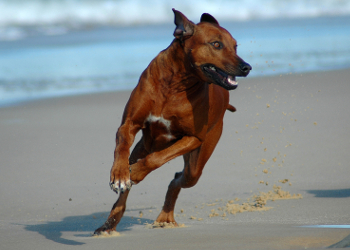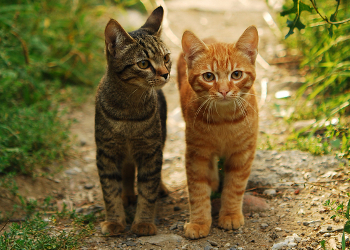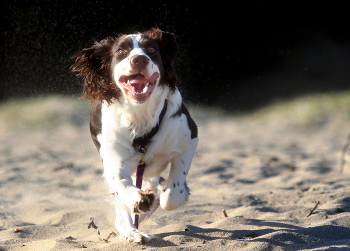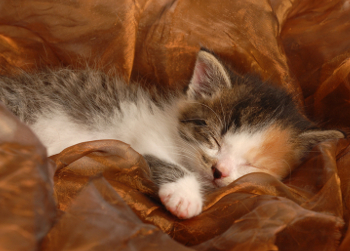Diseases #13 Copy

Umbilical hernias are commonly seen in dogs and cats. They also go by the name of omentoceles. An umbilical hernia is caused by a weakening in the rectus muscle near the umbilicus of the dog or cat.
The majority of umbilical hernias are congenital. They are seen in young animals when they are first brought into a medical office for exam. It is noticeable at birth! The majority of umblical hernias contain small amounts of omentum; the protective fat layer that encases the viscera. The majority of these hernias will seal on their own by the time the animal is 6 months.
If left alone, an umbilical hernia has the potential to expand. Intestinal loops can find their way down into the hernia. They usually will twist and strangulate; losing all their blood supply and begin to decompose. In a pregnant animal, a uterine horn may fall into the hernia by gravity. Development of a fetus in such an environment is dangerous.
In a typical congenital umbilical hernia, a small pouch about a quarter of an inch or so will be seen over the umbilicus. In case of a twisted bowel or uterine horn in the hernia; vomiting, anorexia, depression and a warm swelling over the hernia can be felt.
For a congenital hernia, no lab work is required. For complicated hernias, a CBC and Chemistry profile are warranted as well as radiographs that will delineate the contents of the hernia prior to surgery. In case of infections, there will be a left shift neutrophilic leukocytosis.
A diagnosis of an umbilical hernia is made by the visual presentation of a swelling over the umbilicus of the animal.
The majority usually seal on their own before the animal is 6 months of age. Those that don't are repaired while the animal is being neutered. Sort of like killing two birds with one stone. In the female, it means making the spay incision a bit longer so the hernia can be repaired.
If an intestinal loop is twisted and necrosed, a resection and anastomosis will have to be performed. Depending upon the condition of the uterus, it may be able to be placed back in the abdomen for the rest of the fetal development term. If twisted and decomposing in the hernia, the animal will have to be spayed.
The prognosis for congenital umbilical hernias is excellent. The prognosis for complicated hernias is dependent on the resolution of the intestinal or reproductive issue.
Animals that have umbilical hernias that will be used for breeding purposes should have the umbilical hernia repaired before breeding begins. If owners obtain an adult animal, of either sex, and it has an umbilical hernia, it should be repaired.



Urethral Obstructions are commonly seen in dogs. The cause of the obstruction is usually caused by calculi (stones), a mucous plug obstructing urine flow or a stenosis (narrowing) of the urethral lumen (cavity) caused by excessive straining.
The urethra is the tube that carries urine from the bladder to the outside while urine is being voided. Any interruption in the flow of urine can result in an obstruction. The bladder continues to fill with urine that can back up into the kidneys. This leads to a post renal uremic condition that is a medical emergency.
The most common calculi that are seen are: struvite (magnesium phosphate), oxalates and urates. Urate stones are seen most commonly in Dalmatian dogs. They are the only dog that produces uric acid in the liver instead of urea as a waste product. Uric acid, like the other crystals, come out of solution secondary to a bacterial infection that causes a rise in the urine pH. These crystals than snowball forming clumps of grit or small stones.
Males will obstruct much more commonly because the diameter of the urethra in males is much smaller than the female dog. Females can obstruct but their urethra is relatively larger than the male. Because of this, they are capable of passing stones that would obstruct a male dog.
Clinical signs associated with urethral obstruction are numerous. It is extremely painful. Dogs will frequently attempt to urinate but no urine comes out even after straining for a period of time. It may appear that the dog is constipated but in reality it is obstructed. It may cry out while urinating or when it is picked up by the owner. Many dogs will lick at their genitals trying to alleviate their problem.
A CBC and Chemistry profile have to be performed to figure out if there is any renal involvement secondary to the obstruction. Radiographs or an ultrasound are taken to visualize the urethral calculi and or any stones present in the bladder. I have seen just one stone plugging the urethra and in other cases stones also present in the bladder. Obtaining a urine sample by a ultrasound guided cystocentesis allows a culture of the urine to be performed and a urinalysis to determine the composition of the calculus and other parameters. It also takes pressure off of the urinary bladder.
Diagnosis is made by a history and physical exam. Radiographs, ultrasounds and abdominal palpation lead the way to making a diagnosis.
The initial treatment goal is to get urine flowing again in a normal fashion plus relieve clinical signs of uremic poisoning due to the obstruction. Emergency cystocentesis is performed; drawing off as much urine as possible from the urinary bladder. This will buy you time trying to get the obstruction corrected. Intravenous fluids are administered to start up diluting built up urea wastes. Cystocentesis may have to be repeated until the obstruction is relieved.
An obstruction can be treated medical or surgically. The toughest urethral obstructions are those at the proximal or top part of the urethra; usually about 4 or so inches south of the bladder. They are very difficult to get to. A urinary catheter is inserted up to the obstruction and flushed under high pressure. The goal is to flush the stone into the bladder where it can be retrieved surgically or dissolved via a stone diet. Bladder stones can also be removed from the urinary bladder as well as the stone flushed back into the bladder from the urethra. There are situations where stones become stuck. Trying to dislodge them from below or from within the urinary bladder are fruitless. It is best that those be handled by a board certified surgeon. The perineal area must be dissected down to the urethra and than removed from there. Quite difficult.
The prognosis for urethral obstruction is usually quite good; as long as the obstruction has been relieved and the owner has been diligent about maintaining an appropriate diet and taking frequent urine samples to the hospital for a repeat urinalysis.



The urethra is the tube that normally transports urine from the bladder to the outside while voiding. The most common causes of urethritis in the dog and cat are: a primary bladder infection, tumors, granulomas (scar tissue), bacterial, trauma, urethral calculi (stones) amongst others.
When the urethra becomes inflamed, the mucosa begins to swell. This swelling causes a decrease in the diameter of the urethra making it much harder for urine to pass through. This leads to the associated clinical signs.
Straining to urinate, urinating more frequently, with or with out blood in the urine, are the most common findings. If there is bleeding it is usually at the beginning of the process. Inflammation is very painful in that part of the body. More straining usually produces a narrower urethral diameter. It is a vicious cycle that could lead to an obstruction if the urethral spasms are not halted.
A urinalysis and urine culture are performed to check for causes of urethritis. The presence of bacteria, crystals, blood and urine pH are important findings. Ultrasounds or radiographs are taken to rule out calculi in the bladder and or urethra.
Diagnosis is made by historical findings, a physical exam and laboratory results.
The most common type of urethritis in dogs is a bacterial urethritis secondary or primary to a bladder infection. In cats the most common type of urethritis is due to struvite stone irritation which is secondary to excess of ash/magnesium in the diet. The former is treated with antibiotics for at least two weeks. The latter by relieving the urethral obstruction. Both species are than put on HIll's® Prescription Canine or Feline c/d for life.
The other causes of urethritis such as tumors are treated by surgery or radiation. These are uncommon causes in pets. Trauma cases are treated surgically.
The prognosis for most cases of urethritis is good as long as the primary cause is dealt with. The prognosis for tumors and trauma causes are much more guarded.



Urinary Incontinence is a problem seen in older male or female dogs due to hormonal changes in the body. Incontinence can also be produced by trauma to the lumbosacral plexus that innervates the bladder. This neurological disorder is also caused by vertebral disk prolapse. It is also produced due to excessive stretching of the bladder resulting from a persistent urethral obstruction.
Animals usually know that they need to go outside to go to the bathroom. It is a voluntary act. There is a sphincter muscle that contracts allowing the animal to hold urine. When it relaxes, urine is able to flow to the outside. Urinary Incontinence is an involuntary act.
In the female, bladder control is due to the formation of estrogen. In the male, it is testosterone. Males can develop incontinence to prostate issues such as benign prostatic hyperplasia as they age. In females, the majority of animals have been spayed in the past. This is a small price to pay for not having unwanted pregnancies or gynecological problems such as pyometra and mammary cancers!
In cases of neurological disruption, the urinary bladder fills but the ability to contract the muscle is not there. Urine than fills the bladder than overflows to the outside.
Urinary Incontinence is an involuntary action. Owners will find pools of urine where the animal sleeps. That could be in its bed or on a favorite sofa. The lower limbs of the animal are usually wet from urine. The skin may become inflamed since urine is a skin irritant. Incontinence is much more common in female dogs than males. The animal may walk and urine dribbles out.
Dogs with spinal disorders may not be able to walk or urinate. Picking the dog up and holding it vertically will cause a stream of urine to exit due to the effects of gravity.
A urinalysis has to be performed. Owners often confuse urinary incontinence with a urinary tract infection. They are easily differentiated by a history, physical exam and urinalysis results. Since the majority of these animals are older pets, a CBC and Chemistry should be performed to evaluate renal and liver function. Some thought to be incontinent dogs were just actually hypothyroid. It had nothing to do with their bladder. They just didn't have the energy to get up to urinate! Supplementing with T4 took care of that.
Diagnosis is made by historical findings, results of a urinalysis and a physical exam. The big rule out here is a UTI (Urinary Tract Infection).
The majority of dogs treated for urinary incontinence are older, spayed females. They are also usually overweight. Hormone replacement therapy is the usual way to go. Phenylpropanolamine is the drug that is usually prescribed. In humans (before it was taken off the market for people) it was a nasal decongestant. Given twice a day, the drug is very effective at stopping incontinence in female dogs. Veterinarians used to use the human drug. When it was withdrawn for human use, veterinarians across the country had heart failure; as there was nothing else to treat the problem with. Thank goodness, a veterinary version was produced named Proin®. It must be taken daily for it to be effective.
The only reason that phenylpropanolamine is being used is that the best treatment was pulled by the FDA. It was diethylstilbestrol or DES. A 1mg DES tablet once or twice a week, bingo! Some compounding labs are still able to manufacture it for off label use.
The prognosis for the common incontinence seen in older spayed females is excellent, as long as therapy is maintained. The prognosis for spinal disorders is much more guarded over time.



Eclampsia is a post partum condition seen in lactating females that have delivered an unusually large litter. The cause of eclampsia is do to calcium depletion resulting in low serum levels of the mineral. The bottom line is that the parathyroid glands (responsible for calcium levels) can not keep up with demand.
Calcium is one of the most important elements in our bodies. It is needed to manufacture bone and is essential for milk production. Toy breeds such as Yorkshire Terriers, Maltese and Chihuahuas do not have the reserves to handle calcium demands for a large litter of puppies.
During normal times, a dogs dietary calcium needs are met from dietary needs. When a toy breed becomes pregnant and fetal skeletons start to develop, a strain is put on maternal calcium levels. When she starts to lactate (produce milk) that additional strain on calcium stores bring her close to "the edge". Her body can not keep up with calcium demands.
Eclampsia can occur anytime before the puppies are whelped up to about a month after delivery. The pups are not effected since their needs are being taken care of by the mother.
A drop in serum calcium is the result which leads to all associated clinical signs in the female animal.
The most common sign of low serum calcium levels is a tetany or severe contraction of skeletal muscle. Vomiting, diarrhea, ataxia or disorientation is seen. Animals will eventually become recumbent and spasm. Because of the constant muscle spasms, the dog will become hyperthermic with an elevated rectal temperature. If not treated, coma and death will occur.
A CBC and Chemistry profile are crucial. A profile will show a low serum calcium level of about 7.5 or even lower. Some animals will also be hypoglycemic at the same time. This is always a big problem in tiny dogs; particularly recently born toy breeds or their crosses.
The most important diagnostic aid, outside of blood calcium levels, is the history obtained from the owner. How many puppies were delivered, when were they delivered are just a few of the questions that your veterinarian will ask you.
Treatment is geared towards correcting serum calcium levels and the hyperthermia. An intravenous catheter is placed with fluids for circulatory support. An intravenous bolus of Calcium gluconate is given which immediately stops all signs. This may have to be administered until serum calcium levels return to about 10. Dogs that are hyperthermic will have to be cooled with a cool water bath to reduce body temperature.
Initially, puppies should not be allowed to nurse since they will take essential calcium from the mother's body. They will need to be bottle fed until maternal calcium levels return to normal level or just bottle fed until they are weaned at 5-6 weeks of age.
The prognosis for rapidly diagnosed and treated dogs is excellent. It is simply amazing to see them recover; acting as if nothing was wrong in the first place!
Prevention is not guaranteed but it is a good place to start. Once a toy breed becomes pregnant, it is a good idea to put her on an appropriate calcium supplement. Too much calcium can produce painful deposits in the joints. A product that I have used over the years is PET-TABS® CF. It is a daily dietary supplement that is also matched to the appropriate amount of phosphorous.
Recently pregnant animals should be placed on a high quality puppy diet while they are pregnant. The extra calories and nutrients in puppy food will indirectly aid in fetal skeletal development and lactation.
When the female is about a couple of weeks away from delivery, the veterinarian can draw blood to check the animal's calcium level before she delivers.

